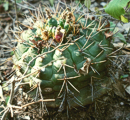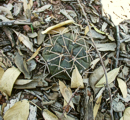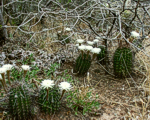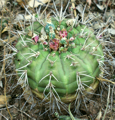|
Gymnocalycium eurypleurum F. Ritter
I was really surprised to see the uniformity in each of the specimen we found. Plants of the habitat do not differ from those raised in greenhouses. The species always grows alone. As already described by Ritter, the number of ribs ranged from 7 to 12 according to size of the plants. Large specimen often develop a short column and reach a diameter of up to 160 mm. The otherwise wide and flat ribs are more hunched with older plants. Gymnocalycium eurypleurum grows in dry forest, at places where the winter bosk (June to September) looses its foliage. Only like this a survival during the dry period is possible. Some 6 m high and nearly impenetrable scrubs constitute the major contingent of plants. Everything seems to either prick or pierce in a way. We find "Opuntien" and different "Bromelien" at the ground. Consistency of the ground varies with the different places of finding. It consists of clayey silt with a layer of loess on top of it. There is almost no creation of humus soil. The soils are full of nutrition, with a ph-value between 6,8 and 7,2. Annual precipitation balance between 500 and 800 mm. Temperatures decrease as far as 0 degree Celsius in winter while in summer rising up to 50 degree Celsius. During our stay, on September 30, 2001 in the beginning of spring, we experienced temperatures of 46 degree Celsius in shade. The area of circulation of G. eurypleurum is even more vast than generally known. We found G. eurypleurum until close to the military station of Fn. Palmar de las Islas, up in the north near the the Bolivian border. Here the species coexisted together with the beautiful Echinopsis chacoana, Gymnocalycium mihanovichii var. stenopleurum and Frailea spec.
|
G. eurypleurum
|

|

|

|

|
| VoS 14 |
VoS 17 |
habitat VoS 20 |
VoS 20 |
|



